Don't wanna be here? Send us removal request.
Link

0 notes
Link
Yes, that is what we offer to you through our Website!
We are all about adding more fun and color to your lives. We want you to get creative and give your space a new look whenever you want, without worrying much about the cost and time.
Find the style that suits your personality and change your monotonous walls into a canvas with endless possibilities.
If you are looking to re-create your home, office, or any other surroundings.. you have found yourself just the right place to be!
0 notes
Text
What is Local Search Marketing?

Local search marketing is anything you do on the web to promote a physical business that makes face-to-face contact with its customers. It applies to both single-location small and medium businesses (SMBs), national enterprise brands, and chains. If a company meets with its customers directly — either through a storefront or service area — it’s termed a “local business” and a unique set of techniques and skills can be used to increase its visibility on the Internet. This may also be referred to as “local SEO,” or local search engine optimization.
Far from being a one-and-done form of marketing, good local SEO builds upon a base of clear business information, using an array of marketing practices to transform an unknown brand into a local household word.
The following graphic gives an overview of the core tasks that make up a local SEO campaign, from the bottom (fundamental) to top (advanced).
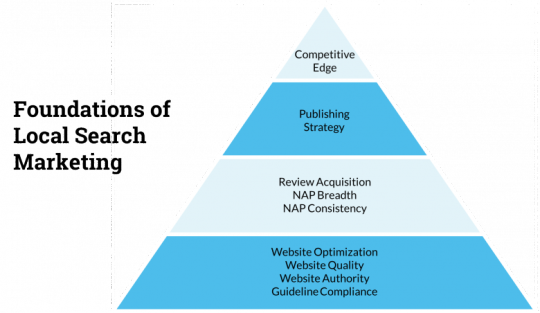
Understanding local search marketing
Mastering local SEO means building on a strong foundation to ultimately gain the competitive edge. Those foundational elements are shown in the pyramid above. Starting from the bottom, let’s define each of these tasks:
Guideline compliance
The way you conceptualize and market your type of local business will be based on the Guidelines for Representing Your Business On Google. Your Google My Business listing is the most important listing you build for your company; failure to comply with Google’s guidelines can result in ranking failures and even listing takedowns. To play it smart, you must be able to see your business the way Google does and follow the appropriate guidelines.
Site authority
Your website can accrue some authority simply by virtue of its age, but you can actively pursue authority by earning links and mentions of your business from a quality, relevant sources. Beware of links from low-quality sources or schemes that attempt to inflate link count with no concern for relevance. Industry surveys indicate that the quality and authority of the links you earn have a major impact on your local search rankings.
Site quality
If your website loads quickly, has a sensible structure, renders properly on all devices, features high-quality content, is free of malware or other malicious elements, and is easy for people to use, you’re meeting basic quality goals. No amount of marketing can make up for poor UX (user experience) on your website.
Site optimization
The search engine optimization (SEO) of your website aims to increase your organic (non-paid) search engine visibility via both technical and creative means. This Beginner’s Guide to SEO breaks down the elements for you.
You must also understand that local SEO consists of everything traditional SEO does, plus geography. In other words, local business websites don’t just focus on keywords about products, services, and topics; they also highly feature terms relevant to the cities in which the business serves.
NAP consistency
“NAP” is the common acronym for “name, address, phone number.” These three pieces of data make up the core of your business information in the world of local search. You’ll also sometimes see this written as NAP+W, with the “W” standing for your website URL. In order for consumers and search engines to trust the data they find across the web about your business, you must make every effort to ensure that its NAP+W is consistent on your website and on all third-party platforms where your business is listed or mentioned.
Publishing strategy
The moment any local business steps onto the web, it becomes a publisher. Your communications with consumers may include the basic text content of your website, a blog, video or image content, owner responses to reviews, and social media participation. Everything you publish should engage customers and expose them to your brand. Search engines not only measure content quality but also the way in which users interact with content, meaning the content you produce should result in high levels of user engagement. Plus, your high-quality content may be shared by your industry and consumer base, further promoting your business. You must devote time and creativity into developing and executing a publishing strategy, for as long as your company is in business.
Competitive edge
The three bottom tiers of our pyramid are fundamental tasks in a typical local SEO campaign. In a competitive industry/geography, your competitors are experts when it comes to these core areas. You must look beyond the basics if you want to stand out from the pack.
Gaining a competitive edge in a crowded market requires a unique effort for each business, based on discovering opportunities your rivals haven’t yet explored.
Say a grocery chain notices that its competitors are not publishing videos on YouTube of a star chef preparing popular/trendy food items. If the grocery chain were to create these videos, they could set the business apart. Competitive difference-makers will be unique to each company and represent the advanced tactics businesses need to undertake when the fundamentals fail to give them an edge. This is where marketing ingenuity comes into full play.
Source: https://moz.com/learn/seo/what-is-local-search-marketing-seo
0 notes
Text
13 Ways Businesses Can Use SEO & Marketing to Combat Coronavirus Impact
You should, at this point, be taking the safety precautions recommended by the World Health Organization (WHO). Many federal governments are stepping up with policies to protect their workers from the certain economic impacts of widespread self-isolation.
In Italy, one of the hardest-hit areas to date, the government negotiated an accord with banks for the suspension of mortgage payments, for example. And in Canada, where I live, the waiting period for unemployment benefits has been eliminated.
There are quite a few reputable resources to help employers and employees prepare for COVID-19, like this WHO guide.
For self-employed individuals and small business owners, help can be harder to find.
How can your business survive the economic impact of a COVID-19 outbreak — or the social distancing required to prevent one?
Keep Calm & Optimize On.
This is not a time for panic.
I’m seeing some alarming accounts from marketing and SEO friends of clients pulling their contracts and shutting down marketing operations until further notice.
This knee-jerk reaction is setting your business up for a long-term, uphill struggle to recover.
Whether you are a landscaping business, a family-owned restaurant, a small retail shop, or some other privately-owned company, you may experience revenue losses in the coming months. Product or service business, ecommerce or brick-and-mortar, we are all bracing for a hit.
There is a lot of uncertainty around the potential economic impacts of COVID-19, and that is certainly scary.

But what is certain is that we will recover.
“Flattening the curve” works as a method of mitigating the damage of a pandemic by not only reducing the volume of cases and therefore the strain on social systems but also spreading the cases out over time, so they can be handled more effectively.
Organic search is a zero-sum game; your gains or losses are exactly balanced by the gains or losses of others in the SERPs.
We understand paid search and social as a live auction but tend not to think of organic this way.
It is very much a living, breathing, competitive space and if you’re not actively moving ahead, you’re falling behind.
Budgeting for Marketing & SEO During Coronavirus Pandemic
If you’re doing anywhere between $1 and $5 million in sales per year you should be spending 7–8% of gross revenue on advertising and marketing, according to the U.S. Small Business Administration.
I’ve worked with high-growth companies budgeting 10–12%, but for maintenance 7% is a bare minimum.
This means for every $100,000 in gross revenue, you should have at least $7,000 earmarked for advertising and marketing per year.
It is critical that you maintain at least this level of marketing investment throughout the Coronavirus pandemic.
If you cannot afford to grow right now, so be it.
If it makes sense to cut back on some paid advertising for the time being (say, for example, your employees can’t come in to serve customers so there’s no point right now in attracting them to your location), then that’s a logical decision to make.
SEO and inbound marketing are a long game, however.
You’ve invested in building your processes and workflow, ensuring data quality with consistent measurement, building an audience and customer base, and creating quality content that ranks.
What’s more, you can count on the fact that others are going to panic and underestimate the impact of an emotional decision on their 6- to 12-month business horizon.
As their engagement drops, their publishing cadence slows, perhaps their review volume or quality falls off, and they lose traction across channels, you have the opportunity to push ahead and come out on top.
This is the time to stay the course and tackle all of those potentially impactful SEO and marketing tasks you’ve had on your back burner.
Whether you’re working with an agency or handling marketing in-house, these are tasks you can get your team working on while they self-isolate and work remotely.
13 SEO & Marketing Tasks to Do NOW for a Faster Coronavirus Recovery
1. Interview Employees & Customers
Use Zoom or Google Hangouts to host and record video calls.
Interview your employees and customers about their unique experiences with and knowledge of your products, services, and culture.
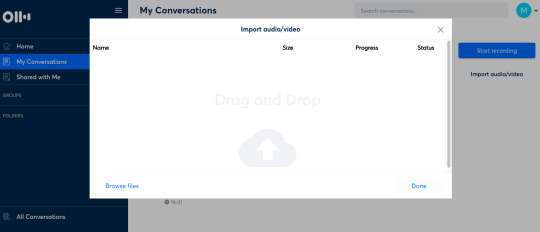
Use Otter.ai for automated video transcription
In the coming months, these transcripts and videos will be a rich source of insider info for your blog posts, social content, media releases, and more.
2. Do a Mini-Audit of Your Content Assets
A full-blown content audit takes time and expertise, but there is much you can do during this slow period to improve your content performance with a mini-audit.
If you haven’t kept an inventory of your content assets to date, this is a great time to get started.
Create a new Google Sheet or Excel sheet and use one tab for each content type:
· Webpages.
· Emails.
· Blog posts.
· Whitepapers.
· Ebooks.
· Presentations.
· Videos.
· Infographics.
· Articles you’ve published externally.
Etc.
If you get really ambitious, you can track articles others have published about your business, too.
Now evaluate each piece with a critical eye.
· Which high-quality pieces and images can you repurpose for other channels?
· Which pieces got the most social shares? The most backlinks?
· Which ones get the most traffic on-site?
These may all be opportunities for:
· Updating with fresh content.
· Optimizing with new CTAs and keywords.
· Adding internal links to new products/services.
· Repromoting when business picks up again.
3. Plan Webinars
Want to answer frequently asked questions about your approach to small engine repair?
Introduce new team members, products, or features to your customer base?
Inspire seasonal bookings for later this year?
If you’re constantly tied up in the field and now freaking out in an empty office twiddling your thumbs, this is a great time to try out your webinar game.
This is an especially effective marketing tactic in B2B, as 91% of professionals say webinars are their favorite content format for learning.
4. Clean up Your Administrative Messes
“Here are some of the things I’m planning to do:
· Administrative work: clean up files, delete things I don’t need anymore, close open contracts that shouldn’t be open.
· Website: write some posts I’ve been meaning to get to that have evergreen advice, and do a long overdue SEO clean up.
· Webinars and Podcasts: research some that I can pitch to and work on some pitches and ideas for the future.
· Books: read that stack of marketing books I haven’t gotten to!” — Jenny Halasz
5. Take Aim at Different Types of SERPS
If you’re like a lot of small business owners, you haven’t had time to even think about getting any more sophisticated than having a presence in search and maybe trying to balance your organic and PPC efforts for good coverage.
Now that you may have a bit of time and space to dig deeper, you can plot your domination of position zero, video carousels, paragraph snippets, and more.
6. Get Recording Videos
Videos are great SEO fodder on their own, they can help you:
· Target long-tail keywords.
· Trigger featured snippets.
· Appear in relevant YouTube searches.
But they can also be the basis for all types of other content, too.
As mentioned above, Otter.ai is a low-cost way to transcribe video with AI (and if you have employees in need of at-home work, you can get them to watch the video and clean up the transcripts, as the tech isn’t perfect).
Embed the video in a blog post and include the transcript.
Take screenshots and use them as images in social.
Take 5–10 quotes from the video transcript and use them alongside images on Instagram in the coming months.
Reuse those quotes in media releases and upcoming blog posts.
7. Work on Your Online Reviews Strategy
The web is littered with online reviews companies haven’t answered.
You don’t have to go back to the dawn of Yelp time and answer each one, but this is a good time to make sure your more recent reviews have a thoughtful response.
Create a reviews policy and, if you have a good candidate, train an employee now to manage your online reviews going forward.
Write some template responses and go over your brand messaging with them.
Coach them on responding to negative reviews and escalating legit customer service issues to the right person.
Give them the tools they need to monitor reviews and get alerts.
Show them what you expect as far as measuring the value of reviews and monthly reporting.
8. Get Behind Digital in a Big Way
“Get your storefront online so that people can shift from personal shopping to parcel delivery. Get better at video. Loom just halved their rates. I got a 1-year Pro plan today for $48USD/year. It’s a massive tool for sharing information with clients and contacts. Evangelize telecommuting. Share the word about remote tools like Skype, Zoom, Google Docs, etc.” — Shawn DeWolfe
9. Update Your Google My Business Profile for Local Customers
Are you operating on special hours?
Taking special care to avoid the spread of COVID-19?
Google wants local businesses to use the tools available within the GMB dashboard to let customers know what’s changed.
Update your hours and business description, share Google Posts with updates and offers, and make sure your contact information is correct in case people are trying to reach you.
10. Show Your Website Some Love
“Fix your site. You know it’s not perfect, spend some time practicing what you preach and make your site the lead magnet it needs to be!” — Grant Simmons
11. Sniff out Unnatural Links
In her recent column, Anna Crowe shared a couple of pretty compelling stories about the importance of seeking and destroying unnatural backlinks.
In one case, a site had received a manual Google penalty but achieved a top 3 positioning within weeks of removing a disavow file and removing over 1,900 unnatural links.
In another, a site lost 82% of its traffic after building thousands of unnatural links.
There are a lot of different ways unnatural links can happen, and they’re not all intentional.
An unscrupulous SEO here, a shady competitor there and suddenly you can’t figure out why your SEO efforts aren’t paying off.
In How to Find Unnatural Links to Your Site & What to Do About Them, Crowe explains 11 types of unnatural links to watch out for and lays out a step-by-step process for sussing them out.
12. Consider an Outreach Strategy
Whether or not reaching out to your customers during a pandemic is appropriate depends entirely on your type of business, your existing relationship with customers, and the purpose of the communication.
Are customers used to hearing from you regularly by email, SMS messaging or social media?
Don’t let that relationship drop off.
Stay away from tacky disaster-related promotions (looking at you, American Apparel with your Hurricane Sandy Sale).
What you can do is get creative and think of how you can offer reassurance, social connection, or tangible assistance during COVID-19.
“Making the decision to cut your budget at this time is reactionary rather than strategic. SEO and online marketing are avenues to build connection and trust with people and how you do that during challenging times matters just as much as when you’re ready to serve or sell them directly.” — Marketing and SEO strategist Monisha Bajaj
“Making the decision to cut your budget at this time is reactionary rather than strategic,” explains marketing and SEO strategist Monisha Bajaj.
“SEO and online marketing are avenues to build connection and trust with people and how you do that during challenging times matters just as much as when you’re ready to serve or sell them directly.”
· Could you host an online video space once a week for people to check-in, have a light discussion on trends in your industry, and maybe trade tricks or tips relevant to your product or service?
· Can you be a local leader in distributing reputable information to your community about COVID-19 supports? Remember that a lot of places no longer have a local newspaper or radio station. If you have the time to gather information from local government and health agencies and make sure people know where they can get tested for Coronavirus, what steps they should take to report symptoms, etc., why not publish it in a blog or your email newsletter? Include a disclaimer that you are not giving medical advice, and always link back to the original source of the information so people can verify it for themselves.
· Let customers know how your business is changing or adapting to protect them and your employees. Encourage conversation and be forthcoming in answering questions or concerns they may have.
13. Get to Know Customers Better With a Deep Dive Into Your First-Party Data
“Go through your analytics and sales/lead data. What do you know about your customers? What do you know about prospects that didn’t pick you (or about people near your business that don’t shop with you)? What is in the analytics data that you have missed in the past — are they on iPhones, all visit from city X? Compare offline and online trends and determine what could you fix today that you have never had time to do.” — Dave Rohrer
And Remember, Put On Your Own Oxygen Mask First��
Supply chain interruptions, the need for social distancing, and impending economic uncertainty are all serious stressors for business owners.
You have responsibilities to employees, customers, and other stakeholders — but you need to take care of yourself so you’re in shape to take care of those others, first.
The WHO has released a document entitled Mental Health Considerations During COVID-19 Outbreak that I recommend as a resource for all of us struggling to come to terms with this fast-evolving threat.
Words matter. Perspective matters.
Focusing on the future and what we can do to prepare for recovery matters.
Do you have plans to tackle certain aspects of your business if you experience a slow-down? Share your tips for others in the comments.
SOURCE: https://www.searchenginejournal.com/seo-marketing-combat-coronavirus-impact/354780/
0 notes
Text
Marketing in Times of Uncertainty - Whiteboard Friday
Our work as marketers has transformed drastically in the space of a month. Everyone’s looking for an answer on how to do our jobs empathetically and effectively through one of the most difficult trials in modern memory.
We hope you’ve got a cozy seat in your home office, a hot mug of coffee from your own kitchen Keurig, and your cat in your lap as you join us for today.
Video Transcription
I think that now is the right time to talk about marketing in uncertain epochs like the one we’re living through. We obviously have a global crisis. It’s very serious. But most of you watch Whiteboard Friday. They want to help people through this crisis. And that means doing marketing. And I don’t think that now is the right time for us to stop our marketing activities. In fact, I think it’s time to probably crunch down and do some hard work.
So let’s talk about what’s going on. And then I’ll give some tactics that I hope will be helpful to you and your teams, your clients, your bosses, everyone at your organizations as we’re going through this together.
The Business World Is Experiencing Widespread Repercussions
First off, we are in this cycle of trying to prevent massive amounts of death, which is absolutely the right thing to do. But because of that, I think a lot of us in the business world, in the marketing world, are experiencing pain, particularly in certain industries. In some industries obviously demand is spiking, it’s skyrocketing for, you know, coronavirus-related reasons. And in other cases, demand is down. That’s because we sort of have this inability to go out.
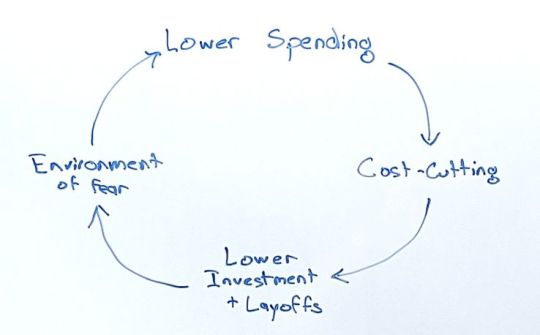
We can’t go to bars and restaurants and movies and bowling alleys and go do all the things we would normally do. So, we don’t need fancy clothes to go do it and we don’t need haircuts — this is probably the last Whiteboard Friday I would want to record before needing a cut. And all of that spending, right, that consumer spending affects business-to-business spending as well.
Lower spending → cost-cutting → lower investment/layoffs → environment of fear…
It leads to cost cutting by businesses because they know there’s not as much demand. It leads to lower investment and oftentimes layoffs as we saw in the United States, where nearly 10 million workers are are out of work, according to the latest stats from the federal government. And that builds this environment of fear, right. None of us have faced anything like this. This is much bigger and worse, at least this spike of it is, than the Great Recession of 2008. And, of course, all of these things contribute to lower spending across the board.
However, what’s interesting about this moment in time is that it is a compressed moment. Right. It’s not a long-term fear of of what will happen. I think there’s fears about whether the recession will take a long time to recover from. But we know that eventually, sometime between 3 and 18 months from now, spending will resume and there will be this new normal. I think of now as a time when marketing needs to change its tone and attitude.
Businesses need to change their tone and attitude and in three ways. And that’s what I want to talk through.
Three Crucial Points
1. Cut with a scalpel, not with a chainsaw
First off, as you are looking to save money and if you’re an agency, if you’re a consultant, your clients are almost certainly saying, “Hey, where can we pull back and still get returns on investment?” And I think one of the important points is not to cut with a chainsaw. Right. Not to take a big whack to, “Oh, let’s just look at all of our Google and Facebook ad spending and cut it out entirely.” Or “Let’s look at all of our content marketing investments and drop them completely.” That’s not probably not the right way to go.
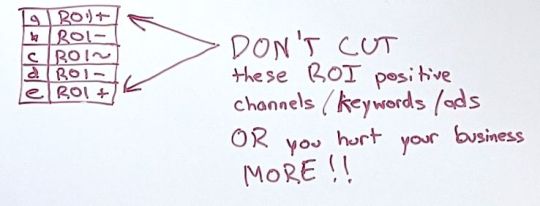
Instead, we should be looking to cut with a scalpel, and that means examining each channel and the individual contributors inside channels as individuals and looking at whether they are ROI-positive. I would urge against looking at a say, one-week, two-week, three-week trend. The last three weeks spending is very frozen and I believe that it will open up more again. I think most economists agree. You can see that’s why the the public stock markets have not crashed nearly as hard. We’ve had some bouncing around.
And I think that’s because people know that we will get to this point where people are ordering online. They are using businesses online. They are getting deliveries. They are doing activities through the Internet over the course of however long we’re quarantined or there is fear about going out and then it will return to a new normal.
And so because of that, you should probably be looking something like six to twelve weeks in the past and trying to sort out, OK, where are the trends, where are their lifelines and opportunities and points of light? And let’s look at those ROI-positive channels and not cut them too soon.
Likewise, you can look inside a channel. If you haven’t seen it already, I highly recommend Seer Interactive’s guide to cutting with a scalpel, not a sledgehammer, and they look at how you can analyze your Google Ads accounts to find keywords that are probably still sending you valuable traffic that you should not pull back on. I would also caution — I’ve talked to a bunch of folks recently who’s seen Facebook and Instagram and Twitter and YouTube and Google ad inventory at historically low prices. So if you have ROI-positive channels right now or your clients do, now is an awesome time to be to potentially be putting some dollars into that.
2. Invest now for the second & third waves in the future
Second thing, I would invest now for the second and third waves. I think that’s a really smart way to go. You can look at Harvard Business Review and Bloomberg and a bunch of folks have written about investing during times of recession, times of fear, and seeing how. Basically when we when we go through wave one, which I think will be still another two to six weeks, of sort of nothing but virus-related news, nothing but COVID-19, and get to a point where we’re transitioning to this life online. It’s becoming our new every day. And then getting to a post-crisis new normal, you know, after we have robust testing and quarantining has hopefully worked out well. The hospital systems aren’t overwhelmed and maybe a vaccine as is near development or done.

When those things start to come, we will want to have now messaging and content and keyword demands serving. Right. And ads and webinars. Anything that is in our marketing inventory that can be helpful to people, not just during this time, but over the course of these, because if we make these investments now, we will be better set up than our competitors who are pulling back to execute on this. And that is what that research shows, right, that essentially folks who invest in marketing, in sales during a recession tend to outperform and more quickly outperform their competition as markets resume. You don’t even have to wait for them to get good — just as they start to pick up.
3. Read the room

The third and possibly most important thing right now is, I think, to read the room. People are paying attention online like never before. And if you’re doing web marketing, they’re paying attention to your work. To our work. That means we need to be more empathetic than we have been historically, right? They are. Our audiences are not thinking about the same things they were weeks ago. They’re in a very new mindset. It doesn’t matter if they’re business-to-business or business-to-consumer. You are dealing with everyone on the planet basically obsessed with the conditions that we’re all in right now. That means assuming that everyone is thinking about this.
I really think the best type of content you create, the best type of marketing you can create right now across any channel, any platform is stuff that helps first. Helps other people. It could be in big ways. It could be in small ways.

The Getty Museum, I don’t know if you saw Avinash Kaushik’s great post about the Getty Museum. They did this fun thing where they took pictures from their museum, famous paintings and they put them online and said, “Hey, go around your home and try and recreate these and we’ll post them.” Is it helping health care workers get masks? No. But is it helping people at home with their kids, with their families, with their loved ones have a little fun, take their mind off the crisis, engage with art in a way that maybe they can’t because they can’t go to museums right now? Yeah, that’s awesome. That’s fine. It’s okay to help in little ways, too, but help first.
I also think it’s okay to talk about content or subjects that are not necessarily related to the virus. Look, web marketing right now is not directly related to the coronavirus. It’s not even directly related to some of the follow-on effects of that. But I’m hoping that it’s helpful. And I’m hoping that we can talk about it in empathetic and thoughtful ways. We’d just have to have to read the room.
It is okay to recognize that this crisis is affecting your customers and to talk about things that aren’t directly related but are still useful to them.
And if you can, I would try not to ignore this, right? Not to create things that are completely unrelated, that feel like, “Gosh, this could have been launched at any time in the last six months, sort of feels tone deaf.” I think everything that we do is viewed through the lens of what’s happening right now. And certainly I have that experience as I go through online content.
Do not dismiss the scenario. I think that that history will reflect very poorly. History is moving so fast right now that it is already reflecting poorly on people who are doing this.
Don’t exploit the crisis in a shameless way. I’ve seen a few marketing companies and agencies. I won’t point them out because I don’t think shaming is the right thing to do right now, but show how you’re helping. Don’t exploit by saying “It’s coronavirus times. We have a sale.” All right? Say, “Oh, we are offering a discount on our products because we know that money is tight right now and we are helping this crisis by donating 10 percent of whatever.” Or, “We are helping by offering you something that you can do at home with your family or something that will help you with remote work or something that will help you through whatever you’re going through,” whatever your customers are going through.
Don’t keep your tone and tactics the same right now. Oh, yes, I think that’s kind of madness as well. I would urge you, as you’re creating all this potentially good stuff, new stuff, stuff that plans for the future and that speaks to right now, go ahead and audit your marketing. Look at the e-mail newsletters you’re sending out. Look at the sequential emails that are in your site onboarding cycles. Look at the overlay messaging, look at your home page, look at your About page.
Make sure that you’re either not ignoring the crisis or speaking effectively to it. Right. I don’t think every page on a website needs to change right now. I don’t think every marketing message has to change. But I think that in many cases it’s the right thing to do to conduct an audit and to make sure that you are not being insensitive or perceived as insincere.
All right, everyone, I hope that you are staying safe, that you’re staying at home, that you’re washing your hands. And I promise you, together, we’re going to get through this.
SOURCE: https://moz.com/blog/marketing-in-times-of-uncertainty
0 notes
Text
Twitter Suggests Appropriate Ways for Brands to Tweet About COVID-19

Twitter is providing guidance to businesses on how to best tweet about corona virus as the situation becomes more serious with each passing day.
The company prefaces its advice by stating “this is not a marketing opportunity to capitalize on.” To that end, businesses are advised not to opportunistically link themselves to a health scare.
Currently, there is a COVID-19 related tweet every 45 milliseconds and #coronavirus is the second most used hashtag of 2020. Before joining in the discussion, Twitter suggests asking whether or not it’s appropriate for your specific brand.
“This is not about looking at what others are doing and copying. It’s about understanding the unique role your brand plays in people’s lives, how that has changed, and how your brand can help or be useful during this crisis.”
Should Your Business Tweet About Coronavirus?
Twitter identifies the situations in which businesses should tweet about COVID-19.
If COVID-19 is affecting your company
If you have important information that affects your company, or your employees (e.g. around transmission of the virus), Twitter says you should consider sharing that publicly.
If COVID-19 may affect your customers
If COVID-19 is directly affecting your business and your customers, Twitter suggests utilizing the platform to interact with your customers one on one.
Twitter gives the example of travel companies communicating changes to their booking policies:
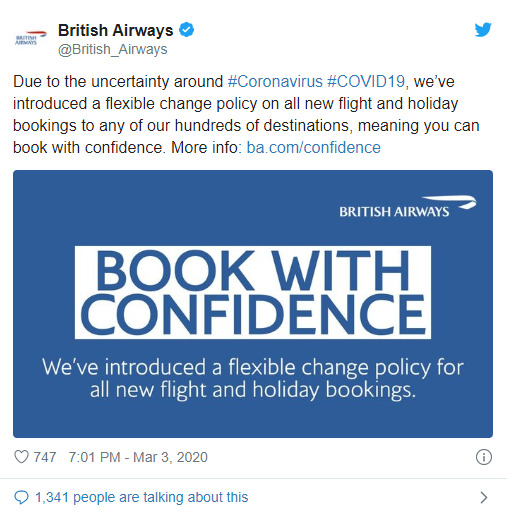
If in doubt, ask yourself these questions
If you’re still questioning whether or not to tweet about coronavirus, ask yourself:
· Can my business share positive stories that might uplift people on Twitter?
· Does my business have positive initiatives that can be discussed?
· Can my business bring the community on Twitter together in a positive way?
Advice for Businesses Tweeting About Coronavirus
After reading the above section, and you feel it’s appropriate for your business to tweet about coronavirus, Twitter offers the following pieces of advice:
· Stay informed: Keep a close eye on the news and conversation — what might have felt like a good message yesterday might not be the right thing today.
· Use the right tone: Right now might not be the best time to be snarky or sarcastic — while empathy and understanding may go a long way.
· Anticipate customer changes: There’s expected to be an increased shift to e-commerce and a significant boom in live-streaming.
Source: Twitter
Source: https://www.searchenginejournal.com/twitter-suggests-appropriate-ways-for-brands-to-tweet-about-covid-19/354550/#close
0 notes
Text
20 (Free) Things You NEED to Do After Launching Your Ecommerce Website

You finally did it.
After many sleepless nights, you’ve finally launched your website. It was a long and arduous journey, but it’s finally over!
Except it isn’t. Not even close.
Launching your website was a big step, but it’s only the first of many.
Just because you have a website up and running, doesn’t mean anybody is actually going to come visit it.
The real work begins now!
Here are the top 20 things you should be doing right after you launch your e-commerce website.
1. Get Your Product Feeds Ready

Your e-commerce website is up, and it’s time to let the world know it!
By submitting a product data feed to shopping channels like Google Shopping and Amazon, you let them know exactly what you are selling. Note that I used the word “exactly.”
That’s because the more comprehensive and specific your product data feed is, the more likely it will show up for relevant searches. Completing the product data feed might be boring and tedious work, but it will help you get the much-coveted buying-intent-filled traffic all e-commerce websites desire.
2. Install a Backup Plugin
Your new site is now up and running. You’ve put a lot of work into it, and you want to protect your investment. This is the perfect time to set up a backup plugin to make sure your hard work is protected.
In a world full of server crashes and security breaches, a plugin that creates regular backups can give you some invaluable peace of mind that your site can easily be restored in case anything goes wrong. It’s just the smart thing to do.
3. Set Up Your XML Sitemap File

Everybody publishing a website wants to be seen, and creating a sitemap.xml file will help to ensure that yours is.
This file lists and organizes all the pages and URLs of your website, letting Google read and understand it much more effectively. Doing this will help Google index your entire site and rank it better.
The best part is, if you’re using WordPress, it is really easy to do.
Simply install the Google XML Sitemaps plugin, and you’ll have that sitemap.xml file ready before you can say “Hey Google, notice me!”
4. Spread the Word on Social Media
If you’ve just launched a new website, you want to get as many visitors on it as you can. One of the simplest ways to do that is simply to promote your website on social media. Facebook, Twitter, and Instagram all boast users in the millions. Take advantage of that audience by promoting your site on these platforms as much as you can. Let your Facebook friends and Twitter and Instagram followers know that you’ve got something new that they might find of value.
It just makes sense!
5. Set Up Your Website’s Social Media Accounts
It’s one thing to promote your website on your social media accounts — it’s an entirely different thing to create social media accounts for it.
A well-curated social media account can add legitimacy and authority to your website. People are more likely to trust a website that is highly visible on social media than one with no social media presence at all. After all, the more subscribers and followers you have, the more convincing you usually are. That’s why it’s important to get started on your website’s social media accounts as soon as possible.
6. Create More Content
If you think that launching the website was the hard part, then you’ve got another thing coming. That was actually the easiest part of the journey. Now you’ve got to get to producing a steady stream of content to keep your site relevant and current. Nobody wants to visit a stale website. You can never have enough content.
You’ve got to keep churning out new content or your launch is going to be the highlight of your website.
7. Configure Google Analytics
In all the excitement of your website launch, don’t forget to configure your website with Google Analytics. Doing this will let give you access to the data that you will find to be incredibly valuable if you want to grow your website.
This includes:
-The number of site visitors.
-How your keywords are doing.
-Where your website traffic is coming from.
-Who exactly your traffic is.
-And much more data.
All it takes is a little bit of Google code.
If you’re serious about growing your website’s audience, then having Google Analytics is definitely a must.
8. Send Out A Press Release
Your new website is up, but chances are, nobody knows what it’s all about.
That’s why sending out a press release can prove to be valuable. This serves as a first initial introduction to who you are and what your website is about. Your press release doesn’t have to be a long, either. A concise introduction is all you need to let me people know you’re in business.
9. Get Your Site SEO-Ready
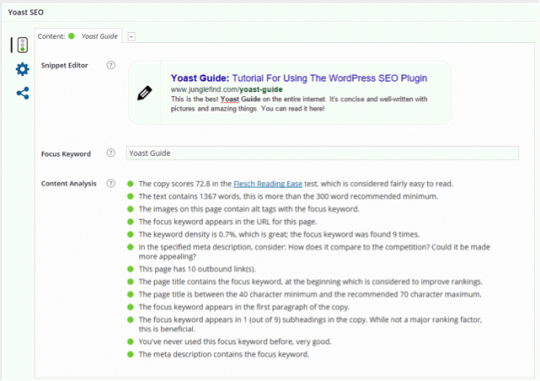
Promoting your new website on social media and email may get you some good traffic, but nothing beats Google when it comes to reaching some serious numbers.
That’s why getting your site’s SEO right is such a big deal. More traffic means more potential sales and leads for your new e-commerce website. Now SEO is incredibly complicated, but you don’t need to be an expert on it. There are lots of SEO plugins out there like Yoast SEO that can make SEO simple, and really make a big difference in how Google ranks your website. It’s definitely something you have to set-up right away.
10. Change Your Permalink Structure
Permalinks are permanent links that people (and maybe more importantly, Google) uses to recognize the individual pages of your website.
WordPress’ default permalinks aren’t very SEO-friendly.
After all, how does the permalink “yoursite.com/?p=101” add any value in Google’s eyes?
Instead, setting the permalink to your post title would be much more useful for SEO purposes.
As an added bonus, anybody reading “yoursite.com/post-title” can get a quick idea of what the page is all about at a glance.
11. Set Up Google Search Console

Google Search Console (GSC) should be one of the very first things you set up on your new website. GSC allows you to understand how Google sees your website. This is extremely valuable because if you can understand how Google sees your website, you can take specific steps to improve your ranking. It also shows you who is linking back to your website, as well as point out internal errors, if there are any. You can also see how your site appears in the search engine results, and let you know which keywords your site is showing up for.
12. Beef Up Security
You’ve just launched your website and are probably feeling like a proud new parent right about now. That pride is soon replaced by dread, as you realize there are terrible things out there looking to do your baby wrong: mainly malware, viruses, and hackers.
For peace of mind, look to install a firewall of some sort to protect your website from all these things. There are tons of free security plugins out there, and you should take advantage.
13. Enable Caching
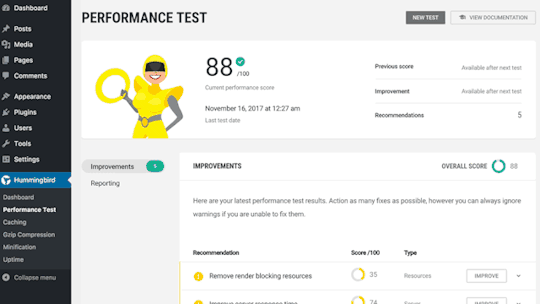
Your site may be brand spanking new, but if it loads like an old car from the junkyard, nobody is going to want to stay on it.
Content is king, but speed is always a major factor when it comes to keeping visitors happy. Installing a free caching plugin will allow your site to reduce loading speeds significantly. There are lots of free caching services out there, so it doesn’t make sense not to take advantage.
14. Take Advantage of Google Alert Mentions
This is by far the easiest way to keep your finger on the pulse.
Setting Google Alert Mentions to your website name and specific keywords you’re tracking can let you know exactly what people are saying about your website and your specific keywords. This way, you will know what’s current and relevant about the things you are promoting/selling/writing about. You’ll also know exactly what kind of content your competition might be coming out with.
Knowing these things as they happen will allow you to respond accordingly.
15. Set Up Email List Sign-Ups
Website traffic is great, but the main point of it is to get into their inboxes.
That’s where you can build relationships, promote ideas, and really sell products to the people. That’s why it is of utmost importance that you set up a way for your website visitors to leave their emails with you. Of course, having an email list signup form available is a completely different thing from getting your traffic to actually sign up for it.
Come up with creative incentives to convince your audience that joining your email list will be of value to them, such as offering a free e-book or access to gated content.
16. Take Advantage of HARO
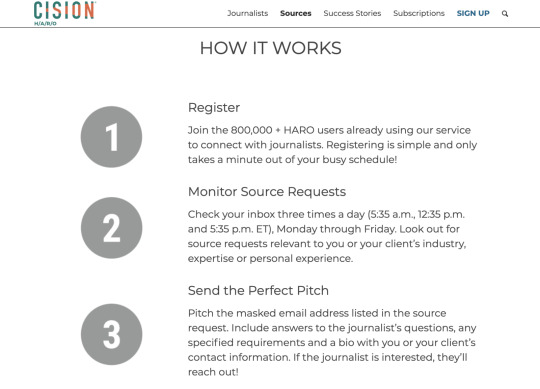
Help A Reporter Out or HARO is a service that can get you some serious press for free. Signing up will get you three emails a day with questions from journalists. If you see any questions you can answer, send an in-depth response to the mystery journalist. If your response piques their interest enough, they will reach out and most probably use you as an expert source for whatever they are writing. They get an expert source of information and you get some free exposure. Everybody’s happy!
17. Create A Press Page
This is where you can tell your website’s story.
It should talk about what your website is all about, how it came to be, and the key details that make it unique. This press page is something you will be linking to whenever you are writing to people about your website, so you should take great care to make sure everything is perfect.
Make sure the story is clear, and that the copy is grammatically perfect.
18. Reach Out to Website Editors & Bloggers
It might seem like a strange idea to reach out to websites and blogs that are in the same field as you, but getting connected to more established people can really help with your new website’s credibility. Start nurturing a relationship with these people and email them one-by-one to see if they would be willing to work with you.
If the content you have to offer is good, they’ll recognize the value that you bring and maybe even give you a valuable shout-out on their website.
19. Build an Initial Link Foundation
E-commerce or not, every website looking to get higher in the rankings should look to generate inbound links. Inclusion in free (and some paid) directories is an ideal option for businesses with a local footprint or a business without any existing backlinks.
There’s no shortage of entries and submissions, so it might take a while before you actually get on the site. That’s why it makes sense to submit as soon you are launched. It also doesn’t hurt your application to have a great website that offers a lot of quality content, is aesthetically pleasing, and just generally works really well.
20. Add More Products!
A new website usually has much less content on it than one that is more established. That’s why it’s a good idea for e-commerce websites to add more products as soon as possible. This adds valuable content that can help your site with its ranking for certain keywords.
A website with more product selection also looks a lot more legitimate than one that’s almost empty. Implement These Strategies to Fuel Your Sales Machine. Launching an e-commerce website is no easy feat. But it’s what you do after the launch that really determines your success.
Be sure to keep these tips in mind and watch your traffic — and more importantly, sales — shoot through the roof.
Source: https://www.searchenginejournal.com/after-launching-ecommerce-website/346778/#close
0 notes
Text
What Is PPC & How Paid Search Marketing Works
What is PPC? How does it work? And most importantly, how can you make it work for you?
Let’s kick things off with the basics.
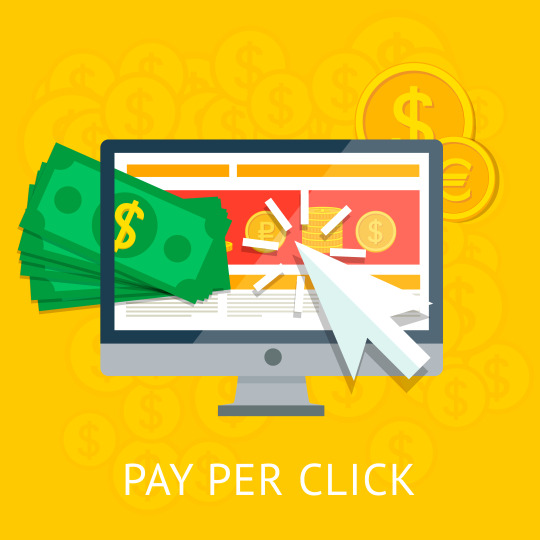
What Is PPC?
Pay-per-click (PPC) is an advertising model that lets marketers place ads on an ad platform and pay the host of that platform every time their ad is clicked. The goal of a PPC ad is to lead the person viewing it to click through to the advertiser’s website or app, where that visitor can complete a valuable action, such as purchasing a product.
Search engines are incredibly popular advertising platforms. They allow you to display ads that are relevant to what users are searching for. Advertising services like Google Ads and Bing Ads operate with real-time bidding (RTB), where advertising inventory is sold in a private automated auction using real-time data.
How Paid Search Works
Every time there is an ad spot on a search engine results page (SERP), an instantaneous auction takes place for the keyword. A combination of multiple factors, including bid amount and the quality of the ad, decide the winner who will appear in the top spot of the SERP. These auctions are what keeps the gears of PPC moving. Auctions begin when someone searches for something on a search engine; if there are advertisers interested in showing ads related to a user’s search query, an auction is triggered based on keywords that are bid on by advertisers. The ads that win the auction then appear on the search engine results page. To get involved in these auctions, advertisers use accounts on platforms like Google Ads to set up their ads and determine where and when they would like those ads to appear. Accounts are split into campaigns for ease of management and reporting of different locations, product types, or another useful categorization.
Campaigns are further divided into ad groups which contain keywords and relevant ads.
Keywords
Keywords lie at the center of PPC, connecting advertisers to users’ search queries. Queries are the actual words that users type into the search box of a search engine in order to find results. Keywords, on the other hand, are what marketers use to target these users by matching their search queries. Keywords work as generalized abstractions of a wide range of search queries, which are prone to irregularities like misspellings.
Depending on the keyword match types they use, advertisers can match search queries with more or less precision. For example, advertisers can choose to match keywords with search queries exactly or to allow for variations such as different orderings of the words, different spellings, or the inclusion of other words. It is also possible to have negative keywords, which will prevent ads being triggered by search queries containing those keywords, in order to avoid irrelevant traffic.
Ads
Along with keywords, you need to prepare ads in your campaigns. These are nestled together within ad groups that target shared sets of keywords, and so are organized by common themes. Ads are what the users will see if the auction is won, so they’re very important to get right.
They typically contain a:
1. Headline.
2. URL.
3. Description.
On a SERP they can show up on top of the results or at the bottom of the page. It’s good practice to test different versions of ad copy to see what performs best. Services like Google Ads and Bing Ads provide features called ad extensions that enhance the appearance of ads.
Examples include:
1. Sitelink extensions, which populate an ad with more links to different pages on a site.
2. Call extensions, which add a phone number to the ad during business hours.
3. Ad extensions are great as they increase the visibility of ads by making them more engaging to users while communicating more information.
Budgets & Bids

In order to participate in the auction, advertisers need to decide how much they’re willing to spend on a given keyword. This is done using:
· Budgets at the campaign level.
· Bids at the ad group or keyword level.
Budgets are set at the campaign level and can be exceeded on a daily basis but will not be overspent on a monthly basis. Budgets should be set according to overall account strategy, but bids are a more precise way of controlling spending.
All ad groups must have bids, but keyword level bids override ad group level bids. Due to the RTB system, the actual amount paid by the advertiser is dependent on competitor activity and ad rank, not just the maximum bid.
Ad Rank
There’s more to winning the auction than having the highest bid.
Search engines look at other factors to determine which ads should be at the top and most valuable spot on the SERP. Search engines have their own particular ways of factoring in other elements to determine ad rank. Google, for example, considers:
· Bid amount.
· Ad relevance and quality.
· The context of the search (such as the user’s device and time of day).
· Format impact (whether it includes extensions that enhance the format of the ad).
Quality Score is a metric that determines ad relevance. The components of Quality Score are:
· Historical click-through rate (CTR).
· Relevance of the keyword to the ad.
· Relevance of the keyword and ad to the search query.
· Landing page quality.
Ad relevance is absolutely essential; the higher Quality Score is, the lower the CPC will be.
Search engines penalize advertisers who bid on keywords with low Quality Scores by rarely showing their ads, even if they have high bids. That’s why it’s very important to have engaging and relevant ad copy that includes high-volume keywords. But landing page quality shouldn’t be overlooked either; ads will show less often when they point to sites with poor user experience.
The webpage must be relevant to the user, load quickly and provide an overall smooth user experience on all devices.
Targeting
Choosing the right keywords is what allows advertisers to show ads to relevant audiences.
But there are other targeting options available to optimize campaigns, including:
· Device.
· Location.
· Day and time.
· Demographics.
This way, advertisers can target users who are on mobile in the evening or users who are under 25 and within a certain radius of a particular location, in order to optimize the performance of their ads.
These targeting options are incredibly valuable because different variations of ad copy, for example, might perform better for one group of users than for another. It can also be possible, using remarketing tools that allow for more specific ad copy messaging and adjusted budgets, to target or exclude past visitors to a website who do follow-up searches.
Bids can be automatically adjusted for keywords based on targeting options, giving advertisers more control over traffic and spend by bidding when customers are more valuable to the business.
Conversions
The point of all this hard work isn’t to just get clicks. The real end game is to obtain conversions. Conversions are the actions that advertisers want users to complete after clicking on an ad and depend on the type of business being advertised.
Common examples of conversions include:
· Purchasing a service.
· Signing up for a newsletter.
· Placing a phone call.
It’s super important to track conversions in order to know whether a PPC campaign is doing well and how many conversions can be attributed to paid search rather than other marketing channels. Platforms like Google Ads can track conversions using a snippet of code that is placed into the source code of the conversion page (which is reached after conversion, like a thank you page) to collect conversion data. Conversion tracking can be a bit tricky, because conversion paths also have a tendency to be more complicated than a simple click on an ad and a direct purchase.
They often include multiple searches and website visits, or can lead to an email, phone call or in-store visit. Using an analytics service like Google Analytics can help to decide how credit for conversions is assigned in conversion paths.
Source: https://www.searchenginejournal.com/ppc-guide/what-is-ppc-paid-search/#close
0 notes
Text
The Who, What, Why, & How of Digital Marketing
With how accessible the internet is today, would you believe me if I told you the number of people who go online every day is still increasing?
It is. In fact, “constant” internet usage among adults increased by 5% in just the last three years, according to Pew Research. And although we say it a lot, the way people shop and buy really has changed along with it — meaning offline marketing isn’t as effective as it used to be.
Marketing has always been about connecting with your audience in the right place and at the right time. Today, that means you need to meet them where they are already spending time: on the internet.
We get a lot of questions from people all around the world about digital marketing. So, we decided to answer them.

What is digital marketing?
Digital marketing encompasses all marketing efforts that use an electronic device or the internet. Businesses leverage digital channels such as search engines, social media, email, and other websites to connect with current and prospective customers.
A seasoned inbound marketer might say inbound marketing and digital marketing are virtually the same thing, but there are some minor differences. And conversations with marketers and business owners in the U.S., U.K., Asia, Australia, and New Zealand, I’ve learned a lot about how those small differences are being observed across the world.
What Is The Role of Digital Marketing To A Company?
While traditional marketing might exist in print ads, phone communication, or physical marketing, digital marketing can occur electronically and online. This means that there are a number of endless possibilities for brands including email, video, social media, or website-based marketing opportunities.
At this stage, digital marketing is vital for your business and brand awareness. It seems like every other brand has a website. And if they don’t, they at least have a social media presence or digital ad strategy. Digital content and marketing is so common that consumers now expect and rely on it as a way to learn about brands.
Long story short, to be competitive as a business owner, you’ll need to embrace some aspects of digital marketing.
Because digital marketing has so many options and strategies associated with it, you can get creative and experiment with a variety of marketing tactics on a budget. With digital marketing, you can also use tools like analytics dashboards to monitor the success and ROI of your campaigns more than you could with a traditional promotional content — such as a billboard or print ad.
How Does A Business Define Digital Marketing?
Digital marketing is defined by the use of numerous digital tactics and channels to connect with customers where they spend much of their time: online. From the website itself to a business’s online branding assets — digital advertising, email marketing, online brochures, and beyond — there’s a spectrum of tactics that fall under the umbrella of “digital marketing.”
The best digital marketers have a clear picture of how each digital marketing campaign supports their overarching goals. And depending on the goals of their marketing strategy, marketers can support a larger campaign through the free and paid channels at their disposal.
A content marketer, for example, can create a series of blog posts that serve to generate leads from a new ebook the business recently created. The company’s social media marketer might then help promote these blog posts through paid and organic posts on the business’s social media accounts. Perhaps the email marketer creates an email campaign to send those who download the ebook more information on the company. We’ll talk more about these specific digital marketers in a minute.
Types of Digital Marketing
Search Engine Optimization (SEO)
Content Marketing
Social Media Marketing
Pay Per Click (PPC)
Affiliate Marketing
Native Advertising
Marketing Automation
Email Marketing
Online PR
Inbound Marketing
Sponsored Content
Here’s a quick rundown of some of the most common digital marketing tactics and the channels involved in each one.
Search Engine Optimization (SEO)
This is the process of optimizing your website to “rank” higher in search engine results pages, thereby increasing the amount of organic (or free) traffic your website receives. The channels that benefit from SEO include websites, blogs, and infographics.
There are a number of ways to approach SEO in order to generate qualified traffic to your website. These include:
On page SEO: This type of SEO focuses on all of the content that exists “on the page” when looking at a website. By researching keywords for their search volume and intent (or meaning), you can answer questions for readers and rank higher on the search engine results pages (SERPs) those questions produce.
Off page SEO: This type of SEO focuses on all of the activity that takes place “off the page” when looking to optimize your website. “What activity not on my own website could affect my ranking?” You might ask. The answer is inbound links, also known as backlinks. The number of publishers that link to you, and the relative “authority” of those publishers, affect how highly you rank for the keywords you care about. By networking with other publishers, writing guest posts on these websites (and linking back to your website), and generating external attention, you can earn the backlinks you need to move your website up on all the right SERPs.
Technical SEO: This type of SEO focuses on the backend of your website, and how your pages are coded. Image compression, structured data, and CSS file optimization are all forms of technical SEO that can increase your website’s loading speed — an important ranking factor in the eyes of search engines like Google.
Content Marketing
This term denotes the creation and promotion of content assets for the purpose of generating brand awareness, traffic growth, lead generation, and customers. The channels that can play a part in your content marketing strategy include:
Blog posts: Writing and publishing articles on a company blog helps you demonstrate your industry expertise and generates organic search traffic for your business. This ultimately gives you more opportunities to convert website visitors into leads for your sales team.
Ebooks and whitepapers: Ebooks, whitepapers, and similar long-form content helps further educate website visitors. It also allows you to exchange content for a reader’s contact information, generating leads for your company and moving people through the buyer’s journey.
Infographics: Sometimes, readers want you to show, not tell. Infographics are a form of visual content that helps website visitors visualize a concept you want to help them learn.
Social Media Marketing
This practice promotes your brand and your content on social media channels to increase brand awareness, drive traffic, and generate leads for your business. The channels you can use in social media marketing include:
Facebook.
Twitter.
LinkedIn.
Instagram.
Snapchat.
Pinterest.
If you’re new to social platforms, you can use tools like HubSpot to connect channels like LinkedIn and Facebook in one place. This way, you can easily schedule content for multiple channels at once, and monitor analytics from the platform as well.
Pay Per Click (PPC)
PPC is a method of driving traffic to your website by paying a publisher every time your ad is clicked. One of the most common types of PPC is Google Ads, which allows you to pay for top slots on Google’s search engine results pages at a price “per click” of the links you place. Other channels where you can use PPC include:
Paid ads on Facebook: Here, users can pay to customize a video, image post, or slideshow, which Facebook will publish to the newsfeeds of people who match your business’s audience.
Twitter Ads campaigns: Here, users can pay to place a series of posts or profile badges to the news feeds of a specific audience, all dedicated to accomplish a specific goal for your business. This goal can be website traffic, more Twitter followers, tweet engagement, or even app downloads.
Sponsored Messages on LinkedIn: Here, users can pay to send messages directly to specific LinkedIn users based on their industry and background.
Affiliate Marketing
This is a type of performance-based advertising where you receive commission for promoting someone else’s products or services on your website. Affiliate marketing channels include:
Hosting video ads through the YouTube Partner Program.
Posting affiliate links from your social media accounts.
Native Advertising
Native advertising refers to advertisements that are primarily content-led and featured on a platform alongside other, non-paid content. BuzzFeed-sponsored posts are a good example, but many people also consider social media advertising to be “native” — Facebook advertising and Instagram advertising, for example.
Marketing Automation
Marketing automation refers to the software that serves to automate your basic marketing operations. Many marketing departments can automate repetitive tasks they would otherwise do manually, such as:
Email newsletters: Email automation doesn’t just allow you to automatically send emails to your subscribers. It can also help you shrink and expand your contact list as needed so your newsletters are only going to the people who want to see them in their inboxes.
Social media post scheduling: If you want to grow your organization’s presence on a social network, you need to post frequently. This makes manual posting a bit of an unruly process. Social media scheduling tools push your content to your social media channels for you, so you can spend more time focusing on content strategy.
Lead-nurturing workflows: Generating leads, and converting those leads into customers, can be a long process. You can automate that process by sending leads specific emails and content once they fit certain criteria, such as when they download and open an ebook.
Campaign tracking and reporting: Marketing campaigns can include a ton of different people, emails, content, webpages, phone calls, and more. Marketing automation can help you sort everything you work on by the campaign it’s serving, and then track the performance of that campaign based on the progress all of these components make over time.
Email Marketing
Companies use email marketing as a way of communicating with their audiences. Email is often used to promote content, discounts and events, as well as to direct people toward the business’s website. The types of emails you might send in an email marketing campaign include:
Blog subscription newsletters.
Follow-up emails to website visitors who downloaded something.
Customer welcome emails.
Holiday promotions to loyalty program members.
Tips or similar series emails for customer nurturing.
Online PR
Online PR is the practice of securing earned online coverage with digital publications, blogs, and other content-based websites. It’s much like traditional PR, but in the online space. The channels you can use to maximize your PR efforts include:
Reporter outreach via social media: Talking to journalists on Twitter, for example, is a great way to develop a relationship with the press that produces earned media opportunities for your company.
Engaging online reviews of your company: When someone reviews your company online, whether that review is good or bad, your instinct might be not to touch it. On the contrary, engaging company reviews helps you humanize your brand and deliver powerful messaging that protects your reputation.
Engaging comments on your personal website or blog: Similar to the way you’d respond to reviews of your company, responding to the people who are reading your content is the best way to generate productive conversation around your industry.
Inbound Marketing
Inbound marketing refers to a marketing methodology wherein you attract, engage, and delight customers at every stage of the buyer’s journey. You can use every digital marketing tactic listed above, throughout an inbound marketing strategy, to create a customer experience that works with the customer, not against them. Here are some classic examples of inbound marketing versus traditional marketing:
Blogging vs. pop-up ads
Video marketing vs. commercial advertising
Email contact lists vs. email spam
Sponsored Content
With sponsored content, you as a brand pay another company or entity to create and promote content that discusses your brand or service in some way.
One popular type of sponsored content is influencer marketing. With this type of sponsored content, a brand sponsors an influencer in its industry to publish posts or videos related to the company on social media.
Another type of sponsored content could be a blog post or article that is written to highlight a topic, service, or brand.
To learn more about sponsored content, check out this blog post.
What Does A Digital Marketer Do?
Digital marketers are in charge of driving brand awareness and lead generation through all the digital channels — both free and paid — that are at a company’s disposal. These channels include social media, the company’s own website, search engine rankings, email, display advertising, and the company’s blog.
The digital marketer usually focuses on a different key performance indicator (KPI) for each channel so they can properly measure the company’s performance across each one. A digital marketer who’s in charge of SEO, for example, measures their website’s “organic traffic” — of that traffic coming from website visitors who found a page of the business’s website via a Google search.
Digital marketing is carried out across many marketing roles today. In small companies, one generalist might own many of the digital marketing tactics described above at the same time. In larger companies, these tactics have multiple specialists that each focus on just one or two of the brand’s digital channels.
Here are some examples of these specialists:
SEO Manager
Main KPIs: Organic traffic
In short, SEO managers get the business to rank on Google. Using a variety of approaches to search engine optimization, this person might work directly with content creators to ensure the content they produce performs well on Google — even if the company also posts this content on social media.
Content Marketing Specialist
Main KPIs: Time on page, overall blog traffic, YouTube channel subscribers
Content marketing specialists are the digital content creators. They frequently keep track of the company’s blogging calendar, and come up with a content strategy that includes video as well. These professionals often work with people in other departments to ensure the products and campaigns the business launches are supported with promotional content on each digital channel.
Social Media Manager
Main KPIs: Follows, Impressions, Shares
The role of a social media manager is easy to infer from the title, but which social networks they manage for the company depends on the industry. Above all, social media managers establish a posting schedule for the company’s written and visual content. This employee might also work with the content marketing specialist to develop a strategy for which content to post on which social network.
(Note: Per the KPIs above, “impressions” refers to the number of times a business’s posts appear on the newsfeed of a user.)
Marketing Automation Coordinator
Main KPIs: Email open rate, campaign click-through rate, lead-generation (conversion) rate
The marketing automation coordinator helps choose and manage the software that allows the whole marketing team to understand their customers’ behavior and measure the growth of their business. Because many of the marketing operations described above might be executed separately from one another, it’s important for there to be someone who can group these digital activities into individual campaigns and track each campaign’s performance.
Inbound Marketing vs. Digital Marketing: Which Is It?
On the surface, the two seem similar: Both occur primarily online, and both focus on creating digital content for people to consume. So what’s the difference?
The term “digital marketing” doesn’t differentiate between push and pull marketing tactics (or what we might now refer to as ‘inbound’ and ‘outbound’ methods). Both can still fall under the umbrella of digital marketing.
Digital outbound tactics aim to put a marketing message directly in front of as many people as possible in the online space — regardless of whether it’s relevant or welcomed. For example, the garish banner ads you see at the top of many websites try to push a product or promotion onto people who aren’t necessarily ready to receive it.
On the other hand, marketers who employ digital inbound tactics use online content to attract their target customers onto their websites by providing assets that are helpful to them. One of the simplest yet most powerful inbound digital marketing assets is a blog, which allows your website to capitalize on the terms which your ideal customers are searching for.
Ultimately, inbound marketing is a methodology that uses digital marketing assets to attract, engage, and delight customers online. Digital marketing, on the other hand, is simply an umbrella term to describe online marketing tactics of any kind, regardless of whether they’re considered inbound or outbound.
Does Digital Marketing Work For All Businesses?
Digital marketing can work for any business in any industry. Regardless of what your company sells, digital marketing still involves building out buyer personas to identify your audience’s needs, and creating valuable online content. However, that’s not to say all businesses should implement a digital marketing strategy in the same way.
B2B Digital Marketing
If your company is business-to-business (B2B), your digital marketing efforts are likely to be centered around online lead generation, with the end goal being for someone to speak to a salesperson. For that reason, the role of your marketing strategy is to attract and convert the highest quality leads for your salespeople via your website and supporting digital channels.
Beyond your website, you’ll probably choose to focus your efforts on business-focused channels like LinkedIn where your demographic is spending their time online.
B2C Digital Marketing
If your company is business-to-consumer (B2C), depending on the price point of your products, it’s likely that the goal of your digital marketing efforts is to attract people to your website and have them become customers without ever needing to speak to a salesperson.
For that reason, you’re probably less likely to focus on ‘leads’ in their traditional sense, and more likely to focus on building an accelerated buyer’s journey, from the moment someone lands on your website, to the moment that they make a purchase. This will often mean your product features in your content higher up in the marketing funnel than it might for a B2B business, and you might need to use stronger calls-to-action (CTAs).
For B2C companies, channels like Instagram and Pinterest can often be more valuable than business-focused platforms LinkedIn.
What Is The Role of Digital Marketing To A Company?
Unlike most offline marketing efforts, digital marketing allows marketers to see accurate results in real time. If you’ve ever put an advert in a newspaper, you’ll know how difficult it is to estimate how many people actually flipped to that page and paid attention to your ad. There’s no surefire way to know if that ad was responsible for any sales at all.
On the other hand, with digital marketing, you can measure the ROI of pretty much any aspect of your marketing efforts.
Here are some examples:
Website Traffic
With digital marketing, you can see the exact number of people who have viewed your website’s homepage in real time by using digital analytics software, available in marketing platforms like HubSpot.
You can also see how many pages they visited, what device they were using, and where they came from, amongst other digital analytics data.
This intelligence helps you to prioritize which marketing channels to spend more or less time on, based on the number of people those channels are driving to your website. For example, if only 10% of your traffic is coming from organic search, you know that you probably need to spend some time on SEO to increase that percentage.
With offline marketing, it’s very difficult to tell how people are interacting with your brand before they have an interaction with a salesperson or make a purchase. With digital marketing, you can identify trends and patterns in people’s behavior before they’ve reached the final stage in their buyer’s journey, meaning you can make more informed decisions about how to attract them to your website right at the top of the marketing funnel.
Content Performance and Lead Generation
Imagine you’ve created a product brochure and posted it through people’s letterboxes — that brochure is a form of content, albeit offline. The problem is that you have no idea how many people opened your brochure or how many people threw it straight into the trash.
Now imagine you had that brochure on your website instead. You can measure exactly how many people viewed the page where it’s hosted, and you can collect the contact details of those who download it by using forms. Not only can you measure how many people are engaging with your content, but you’re also generating qualified leads when people download it.
Attribution Modeling
An effective digital marketing strategy combined with the right tools and technologies allows you to trace all of your sales back to a customer’s first digital touchpoint with your business.
We call this attribution modeling, and it allows you to identify trends in the way people research and buy your product, helping you to make more informed decisions about what parts of your marketing strategy deserve more attention, and what parts of your sales cycle need refining.
Connecting the dots between marketing and sales is hugely important — according to Aberdeen Group, companies with strong sales and marketing alignment achieve a 20% annual growth rate, compared to a 4% decline in revenue for companies with poor alignment. If you can improve your customer’s’ journey through the buying cycle by using digital technologies, then it’s likely to reflect positively on your business’s bottom line.
What Types Of Digital Content Should I Create?
The kind of content you create depends on your audience’s needs at different stages in the buyer’s journey. You should start by creating buyer personas (use these free templates, or try makemypersona.com) to identify what your audience’s goals and challenges are in relation to your business. On a basic level, your online content should aim to help them meet these goals, and overcome their challenges.
Then, you’ll need to think about when they’re most likely to be ready to consume this content in relation to what stage they’re at in their buyer’s journey. We call this content mapping.
With content mapping, the goal is to target content according to:
The characteristics of the person who will be consuming it (that’s where buyer personas come in).
How close that person is to making a purchase (i.e., their lifecycle stage).
In terms of the format of your content, there are a lot of different things to try. Here are some options we’d recommend using at each stage of the buyer’s journey:
Awareness Stage
Blog posts. Great for increasing your organic traffic when paired with a strong SEO and keyword strategy.
Infographics. Very shareable, meaning they increase your chances of being found via social media when others share your content. (Check out these free infographic templates to get you started.)
Short videos. Again, these are very shareable and can help your brand get found by new audiences by hosting them on platforms like YouTube.
Consideration Stage
Ebooks. Great for lead generation as they’re generally more comprehensive than a blog post or infographic, meaning someone is more likely to exchange their contact information to receive it.
Research reports. Again, this is a high value content piece which is great for lead generation. Research reports and new data for your industry can also work for the awareness stage though, as they’re often picked-up by the media or industry press.
Webinars. As they’re a more detailed, interactive form of video content, webinars are an effective consideration stage content format as they offer more comprehensive content than a blog post or short video.
Decision Stage
Case studies. Having detailed case studies on your website can be an effective form of content for those who are ready to make a purchasing decision, as it helps you positively influence their decision.
Testimonials. If case studies aren’t a good fit for your business, having short testimonials around your website is a good alternative. For B2C brands, think of testimonials a little more loosely. If you’re a clothing brand, these might take the form of photos of how other people styled a shirt or dress, pulled from a branded hashtag where people can contribute.
How Long Will It Take To See Results From My Content?
With digital marketing, it can often feel like you’re able to see results much faster than you might with offline marketing due to the fact it’s easier to measure ROI. However, it ultimately depends on the scale and effectiveness of your digital marketing strategy.
If you spend time building comprehensive buyer personas to identify the needs of your audience, and you focus on creating quality online content to attract and convert them, then you’re likely to see strong results within the first six months.
If paid advertising is part of your digital strategy, then the results come even quicker — but it’s recommended to focus on building your organic (or ‘free’) reach using content, SEO, and social media for long-term, sustainable success.
Do I Need a Big Budget For Digital Marketing?
As with anything, it really depends on what elements of digital marketing you’re looking to add to your strategy.
If you’re focusing on inbound techniques like SEO, social media, and content creation for a preexisting website, the good news is you don’t need very much budget at all. With inbound marketing, the main focus is on creating high quality content that your audience will want to consume, which unless you’re planning to outsource the work, the only investment you’ll need is your time.
With outbound techniques like online advertising and purchasing email lists, there is undoubtedly some expense. What it costs comes down to what kind of visibility you want to receive as a result of the advertising.
For example, to implement PPC using Google AdWords, you’ll bid against other companies in your industry to appear at the top of Google’s search results for keywords associated with your business. Depending on the competitiveness of the keyword, this can be reasonably affordable, or extremely expensive, which is why it’s a good idea to focus building your organic reach, too.
How Does Mobile Marketing Fit Into My Digital Marketing Strategy?
Another key component of digital marketing is mobile marketing. In fact, smartphone usage as a whole accounts for 69% of time spent consuming digital media in the U.S., while desktop-based digital media consumption makes up less than half — and the U.S. still isn’t mobile’s biggest fan compared to other countries.
This means it’s essential to optimize your digital ads, web pages, social media images, and other digital assets for mobile devices. If your company has a mobile app that enables users to engage with your brand or shop your products, your app falls under the digital marketing umbrella, too.
Those engaging with your company online via mobile devices need to have the same positive experience as they would on desktop. This means implementing a mobile-friendly or responsive website design to make browsing user-friendly for those on mobile devices. It might also mean reducing the length of your lead generation forms to create a hassle-free experience for people downloading your content on-the-go. As for your social media images, it’s important to always have a mobile user in mind when creating them as image dimensions are smaller on mobile devices, meaning text can be cut-off.
There are lots of ways you can optimize your digital marketing assets for mobile users, and when implementing any digital marketing strategy, it’s hugely important to consider how the experience will translate on mobile devices. By ensuring this is always front-of-mind, you’ll be creating digital experiences that work for your audience, and consequently achieve the results you’re hoping for.
Source: https://blog.hubspot.com/marketing/what-is-digital-marketing
0 notes
Text
Why Search — and SEO — Is Important
In 2009, Bill Gates gave a speech at a private dinner where he famously said: “The future of search is verbs.”
Gates wasn’t talking about the words people type into search boxes, he was instead talking about why people search.
Before we can understand why search is important, we need to take a step back and understand why people search.

Why People Search
In the early days, people searched to find a list of documents that contained the words they typed in. That’s no longer the case.
Today’s searchers search to solve problems, to accomplish tasks, and to “do” something. They might be searching to book a flight, buy something, learn the latest Taylor Swift lyrics, or browse cat photos — but these are all actions. Or, as Gates referred to them, verbs.
When a user starts a search, they’re really starting a journey. Marketers love to talk about something called “the consumer journey.” It’s just a fancy way of referencing a user’s path from the inception of their task to the completion — and most of these journeys start with a search.
The consumer journey has been gradually playing a larger role in search over the last decade. Originally depicted as a funnel wherein users move from awareness to consideration to purchase, this old consumer journey has become outdated (although we still use this model for illustrative purposes and to make persona research easier).
The Evolution of Search & the Consumer Journey
The modern consumer journey no longer represents a funnel, but looks more like a crazy straw — with various twists and turns representing the various channels, mediums, and devices that users interact with today.
In order to fit this new model, search has had to evolve from simple words on the page to understanding the user intent at each phase of the journey. Search is no longer just about keywords but has evolved into providing the right content to the right user at the right time in their journey to help them accomplish their task.
For the users, it’s all about the verbs. For search marketers, it’s all about helping the user on their journey (and, ideally, influencing them a bit along the way.)
Sticking with the crazy straw model, today’s consumer journey no longer happens on a single device. Users may start a search on their mobile device, continue researching on their tablet or work laptop, and ultimately purchase from their desktop at home.
Search isn’t just limited to computers or phones. Users can now search from a variety of devices, including watches, smart glasses, BlueTooth speaker assistants, and even kitchen appliances. In today’s world, even my fridge has its own Twitter account — and search marketers need to be cognizant of how various devices relate to each other and play a part in a user’s search experience.
There’s some healthy debate as to whether this has always been the case, but in today’s always-on hyper-connected world, SEO has morphed into what we’ll call “real marketing.”
Gone are the days of hacks, tricks, and attempting to reverse-engineer algorithms.
Today’s SEO focuses on:
Understanding personas.
Data-driven insights.
Content strategy.
Technical problem-solving.
The 3 Main Tenets of Any Marketing Strategy or Campaign
Search touches all three of these areas:
Attract.
Engage.
Convert.
But the search concentrates heavily on the first phase: Attract.
“If you build it, they will come” may apply to baseball fields, but it doesn’t work with websites.
It’s no longer enough to have an awesome product. You must actively attract customers via multiple channels and outlets.
This is why, despite some claims to the contrary from clients or design agencies, every webpage is, in fact, an SEO page.
If a webpage is involved in attracting visitors, engaging visitors, or converting them, there should be an important SEO component to that page.
Why Is SEO Important?
OK, users, journey, search, verbs — got it. Users are important and many of them start with a search, so the search is important.
But why is SEO important? Isn’t SEO just a developer thing? I heard there was a plugin for it. Can’t Google and Bing just figure out my website?
We started this story with a Gates quote, but it was Google rather than Microsoft that took the philosophy to heart.
Things like Hummingbird, Panda, Penguin, RankBrain, Mobilegeddon, Possum, Pigeon, entities, and AMP essentially have all been attempts by Google to adapt its search algorithm to move from words to actions — and help users accomplish whatever tasks they may be focused on — but they aren’t that simple to understand.
SEO has come a long way from the days of meta data. Sure, there’s a lot of best practices involved that “should” be covered by the development team or a plugin (or built into a framework *cough cough* angular, react, I’m looking at you guys) — but often they aren’t.
Today’s websites are more application than they are a website, and applications come with lots of fancy features that don’t always play nicely with search engines (hi again, angular and react.)
Good SEO Today
A good SEO can not only focus on content, but also help:
Navigate through multiple versions of the same page.
Solve tech issues that render content invisible to search engines.
With proper server settings.
Integrate with social media, content, creative, user experience, paid search, or analytics.
Find ways to speed up your site.
A good SEO professional not only understands the searcher, but the competitive landscape as well. It isn’t enough to just understand the user’s task, search marketers need to understand what other options are in the marketplace, and how they can fill the gap to provide a better solution for the user’s task.
We’ve come a long way from keywords on pages to full-service marketing. SEO pros get to wear multiple hats as they help connect development, information architecture, user experience, content strategy, marketing, social, and paid media teams. It’s a game of give and take — all in an attempt to create something that works for search engines and users.
There are plenty of cautionary tales about things as simple sounding as a site redesign or new CMS system causing a site’s traffic to drop or disappear leaving businesses scrambling. The simple fact of the matter is, most website changes these days affect SEO — and only by including SEO up front and throughout the project can a business hope to see positive results.
So Why Is Search Important?
Search matters because users matter.
As technology continues to evolve, SEOs will constantly deal with new ways of searching, new devices to search on, and new types of searches (like voice search, or searches done by my oven) but the one thing that will remain constant is why people search. The verbs aren’t going away.
One day we might be overrun by AI or upload our consciousness into the singularity — but until then we’ll still need to solve problems and accomplish tasks — and some form of search will always be involved in that.
Source: https://www.searchenginejournal.com/seo-101/why-is-search-important/
0 notes
Text
The Who, What, Why, & How of Digital Marketing

With how accessible the internet is today, would you believe me if I told you the number of people who go online every day is still increasing?
It is. In fact, “constant” internet usage among adults increased by 5% in just the last three years, according to Pew Research. And although we say it a lot, the way people shop and buy really has changed along with it — meaning offline marketing isn’t as effective as it used to be.
Marketing has always been about connecting with your audience in the right place and at the right time. Today, that means you need to meet them where they are already spending time: on the internet.
Enter digital marketing — in other words, any form of marketing that exists online.
We talk a lot about inbound marketing as a really effective way to attract, engage, and delight customers online. But we still get a lot of questions from people all around the world about digital marketing. So, we decided to answer them.
A seasoned inbound marketer might say inbound marketing and digital marketing are virtually the same thing, but there are some minor differences. And conversations with marketers and business owners in the U.S., U.K., Asia, Australia, and New Zealand, I’ve learned a lot about how those small differences are being observed across the world. At this stage, digital marketing is vital for your business and brand awareness. It seems like every other brand has a website. And if they don’t, they at least have a social media presence or digital ad strategy. Digital content and marketing are so common that consumers now expect and rely on it as a way to learn about brands.
Long story short, to be competitive as a business owner, you’ll need to embrace some aspects of digital marketing.
Because digital marketing has so many options and strategies associated with it, you can get creative and experiment with a variety of marketing tactics on a budget. With digital marketing, you can also use tools like analytics dashboards to monitor the success and ROI of your campaigns more than you could with a traditional promotional content — such as a billboard or print ad.
How does a business define digital marketing?
Digital marketing is defined by the use of numerous digital tactics and channels to connect with customers where they spend much of their time: online. From the website itself to a business’s online branding assets — digital advertising, email marketing, online brochures, and beyond — there’s a spectrum of tactics that fall under the umbrella of “digital marketing.”
The best digital marketers have a clear picture of how each digital marketing campaign supports their overarching goals. And depending on the goals of their marketing strategy, marketers can support a larger campaign through the free and paid channels at their disposal.
A content marketer, for example, can create a series of blog posts that serve to generate leads from a new ebook the business recently created. The company’s social media marketer might then help promote these blog posts through paid and organic posts on the business’s social media accounts. Perhaps the email marketer creates an email campaign to send those who download the ebook more information on the company. We’ll talk more about these specific digital marketers in a minute.
What does a digital marketer do?
Digital marketers are in charge of driving brand awareness and lead generation through all the digital channels — both free and paid — that are at a company’s disposal. These channels include social media, the company’s own website, search engine rankings, email, display advertising, and the company’s blog.
The digital marketer usually focuses on a different key performance indicator (KPI) for each channel so they can properly measure the company’s performance across each one. A digital marketer who’s in charge of SEO, for example, measures their website’s “organic traffic” — of that traffic coming from website visitors who found a page of the business’s website via a Google search.
Digital marketing is carried out across many marketing roles today. In small companies, one generalist might own many of the digital marketing tactics described above at the same time. In larger companies, these tactics have multiple specialists that each focus on just one or two of the brand’s digital channels.
Does digital marketing work for all businesses?
Digital marketing can work for any business in any industry. Regardless of what your company sells, digital marketing still involves building out buyer personas to identify your audience’s needs and creating valuable online content. However, that’s not to say all businesses should implement a digital marketing strategy in the same way.
B2B Digital Marketing
If your company is business-to-business (B2B), your digital marketing efforts are likely to be centered around online lead generation, with the end goal being for someone to speak to a salesperson. For that reason, the role of your marketing strategy is to attract and convert the highest quality leads for your salespeople via your website and supporting digital channels.
Beyond your website, you’ll probably choose to focus your efforts on business-focused channels like LinkedIn where your demographic is spending their time online.
B2C Digital Marketing
If your company is business-to-consumer (B2C), depending on the price point of your products, it’s likely that the goal of your digital marketing efforts is to attract people to your website and have them become customers without ever needing to speak to a salesperson.
For that reason, you’re probably less likely to focus on ‘leads’ in their traditional sense, and more likely to focus on building an accelerated buyer’s journey, from the moment someone lands on your website, to the moment that they make a purchase. This will often mean your product features in your content higher up in the marketing funnel than it might for a B2B business, and you might need to use stronger calls-to-action (CTAs).
For B2C companies, channels like Instagram and Pinterest can often be more valuable than business-focused platforms LinkedIn.
What is the role of digital marketing in a company?
Unlike most offline marketing efforts, digital marketing allows marketers to see accurate results in real-time. If you’ve ever put an advert in a newspaper, you’ll know how difficult it is to estimate how many people actually flipped to that page and paid attention to your ad. There’s no surefire way to know if that ad was responsible for any sales at all.
On the other hand, with digital marketing, you can measure the ROI of pretty much any aspect of your marketing efforts.
Here are some examples:
Website Traffic
With digital marketing, you can see the exact number of people who have viewed your website’s homepage in real-time by using digital analytics software, available in marketing platforms like HubSpot.
You can also see how many pages they visited, what device they were using, and where they came from, amongst other digital analytics data.
This intelligence helps you to prioritize which marketing channels to spend more or less time on, based on the number of people those channels are driving to your website. For example, if only 10% of your traffic is coming from organic search, you know that you probably need to spend some time on SEO to increase that percentage.
With offline marketing, it’s very difficult to tell how people are interacting with your brand before they have an interaction with a salesperson or make a purchase. With digital marketing, you can identify trends and patterns in people’s behavior before they’ve reached the final stage in their buyer’s journey, meaning you can make more informed decisions about how to attract them to your website right at the top of the marketing funnel.
Content Performance and Lead Generation
Imagine you’ve created a product brochure and posted it through people’s letterboxes — that brochure is a form of content, albeit offline. The problem is that you have no idea how many people opened your brochure or how many people threw it straight into the trash.
Now imagine you had that brochure on your website instead. You can measure exactly how many people viewed the page where it’s hosted, and you can collect the contact details of those who download it by using forms. Not only can you measure how many people are engaging with your content, but you’re also generating qualified leads when people download it.
Attribution Modeling
An effective digital marketing strategy combined with the right tools and technologies allows you to trace all of your sales back to a customer’s first digital touchpoint with your business.
We call this attribution modeling, and it allows you to identify trends in the way people research and buy your product, helping you to make more informed decisions about what parts of your marketing strategy deserve more attention, and what parts of your sales cycle need refining.
What types of digital content should I create?
The kind of content you create depends on your audience’s needs at different stages in the buyer’s journey. You should start by creating buyer personas (use these free templates, or try makemypersona.com) to identify what your audience’s goals and challenges are in relation to your business. On a basic level, your online content should aim to help them meet these goals, and overcome their challenges.
Then, you’ll need to think about when they’re most likely to be ready to consume this content in relation to what stage they’re at in their buyer’s journey. We call this content mapping.
With content mapping, the goal is to target content according to:
The characteristics of the person who will be consuming it (that’s where buyer personas come in).
How close that person is to making a purchase (i.e., their lifecycle stage).
In terms of the format of your content, there are a lot of different things to try. Here are some options we’d recommend using at each stage of the buyer’s journey:
Awareness Stage
Blog posts. Great for increasing your organic traffic when paired with a strong SEO and keyword strategy.
Infographics. Very shareable, meaning they increase your chances of being found via social media when others share your content. (Check out these free infographic templates to get you started.)
Short videos. Again, these are very shareable and can help your brand get found by new audiences by hosting them on platforms like YouTube.
Consideration Stage
Ebooks. Great for lead generation as they’re generally more comprehensive than a blog post or infographic, meaning someone is more likely to exchange their contact information to receive it.
Research reports. Again, this is a high-value content piece that is great for lead generation. Research reports and new data for your industry can also work for the awareness stage though, as they’re often picked-up by the media or industry press.
Webinars. As they’re a more detailed, interactive form of video content, webinars are an effective consideration stage content format as they offer more comprehensive content than a blog post or short video.
Decision Stage
Case studies. Having detailed case studies on your website can be an effective form of content for those who are ready to make a purchasing decision, as it helps you positively influence their decision.
Testimonials. If case studies aren’t a good fit for your business, having short testimonials around your website is a good alternative. For B2C brands, think of testimonials a little more loosely. If you’re a clothing brand, these might take the form of photos of how other people styled a shirt or dress, pulled from a branded hashtag where people can contribute.
How long will it take to see results from my content?
With digital marketing, it can often feel like you’re able to see results much faster than you might with offline marketing due to the fact it’s easier to measure ROI. However, it ultimately depends on the scale and effectiveness of your digital marketing strategy.
If you spend time building comprehensive buyer personas to identify the needs of your audience, and you focus on creating quality online content to attract and convert them, then you’re likely to see strong results within the first six months.
If paid advertising is part of your digital strategy, then the results come even quicker — but it’s recommended to focus on building your organic (or ‘free’) reach using content, SEO, and social media for long-term, sustainable success.
Do I need a big budget for digital marketing?
As with anything, it really depends on what elements of digital marketing you’re looking to add to your strategy.
If you’re focusing on inbound techniques like SEO, social media, and content creation for a preexisting website, the good news is you don’t need very much budget at all. With inbound marketing, the main focus is on creating high-quality content that your audience will want to consume, which unless you’re planning to outsource the work, the only investment you’ll need is your time.
You can get started by hosting a website and creating content using HubSpot’s CMS. For those on a tight budget, you can get started using WordPress hosted on WP Engine and using a simple them from StudioPress.
With outbound techniques like online advertising and purchasing email lists, there is undoubtedly some expense. What it costs comes down to what kind of visibility you want to receive as a result of the advertising.
For example, to implement PPC using Google AdWords, you’ll bid against other companies in your industry to appear at the top of Google’s search results for keywords associated with your business. Depending on the competitiveness of the keyword, this can be reasonably affordable, or extremely expensive, which is why it’s a good idea to focus on building your organic reach, too.
How does mobile marketing fit into my digital marketing strategy?
Another key component of digital marketing is mobile marketing. In fact, smartphone usage as a whole account for 69% of the time spent consuming digital media in the U.S., while desktop-based digital media consumption makes up less than half — and the U.S. still isn’t mobile’s biggest fan compared to other countries.
This means it’s essential to optimize your digital ads, web pages, social media images, and other digital assets for mobile devices. If your company has a mobile app that enables users to engage with your brand or shop your products, your app falls under the digital marketing umbrella, too.
Those engaging with your company online via mobile devices need to have the same positive experience as they would on desktop. This means implementing a mobile-friendly or responsive website design to make browsing user-friendly for those on mobile devices. It might also mean reducing the length of your lead generation forms to create a hassle-free experience for people downloading your content on-the-go. As for your social media images, it’s important to always have a mobile user in mind when creating them as image dimensions are smaller on mobile devices, meaning text can be cut-off.
There are lots of ways you can optimize your digital marketing assets for mobile users, and when implementing any digital marketing strategy, it’s hugely important to consider how the experience will translate on mobile devices. By ensuring this is always front-of-mind, you’ll be creating digital experiences that work for your audience, and consequently, achieve the results you’re hoping for.
I’m ready to try digital marketing. Now what?
If you’re already doing digital marketing, it’s likely that you’re at least reaching some segments of your audience online. No doubt you can think of some areas of your strategy that could use a little improvement, though.
Source: https://blog.hubspot.com/marketing/what-is-digital-marketing
0 notes
Text
Facebook Commits to Helping Small Businesses During COVID-19 Pandemic
Facebook is making efforts to help small businesses get through the COVID-19 pandemic with several initiatives launched this week. In addition to creating a dedicated hub for businesses affected by the coronavirus outbreak, Facebook is planning to roll out a $100 million grant program. Here’s more information about each of these initiatives.

5 steps offered by Facebook for affected businesses:
Keep yourself safe and informed.
Stay in touch with your customers.
Bring your business online.
Prepare a customer service plan.
Provide a list of frequently asked questions (FAQs).
Small Business Grant Program
Facebook is investing $100 million to help 30,000 eligible small businesses in the over 30 countries where Facebook operates. Details are limited at this point, and applications are not yet open, but this is how Facebook’s grant program is expected to help:
· Keeping the business’s workforce going strong
· Assistance with rent costs
· Connecting businesses with more customers
· Covering operational costs
Eligibility for the program:
Up to 30,000 eligible small businesses in more than 30 countries where Facebook operates will be able to receive the grant. To be eligible to apply, you must:
· Have between 2 and 50 employees
· Have been in business for over a year
· Have experienced challenges from COVID-19
· Be in or near a location where Facebook operates
Applications will be available in the coming weeks. If you want to be notified as soon as applications open you can sign up here.
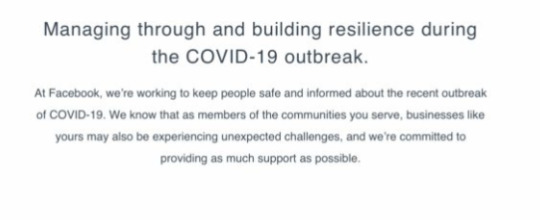
Resources for Small Businesses
Facebook launched a business resource hub in direct response to disruptions caused by COVID-19. The business resource hub includes advice for immediate actions to take, a 30-page business resilience toolkit, and a brief quick action guide. There’s also guides for utilizing Facebook’s products during this time – such as selling products on Facebook and Instagram, and hosting virtual sessions through Messenger and WhatsApp.
Facebook points to some free courses’ businesses can take to make sure they’re getting the most from its suite of products. Ultimately, Facebook recommends continuing to build your brand by posting consistently and encouraging customer interaction.
Expect more resources like these on the horizon, as Facebook COO Sheryl Sandberg says the company has teams dedicated to finding more ways to help people. “We want to do more. Teams across our company are working every day to help businesses. We’re looking at additional ways to host virtual training – and will have more to share in the coming weeks…”
Being a digital marketing agency, we at Techfaktory, advice our readers to follow these measures and enroll in such programs to sustain your business through this pandemic.
Source:
https://www.facebook.com/business/boost/grants
https://www.searchenginejournal.com/
0 notes
Text
Mobile Application and Website Development - A Handbook
Do you remember the time when you wanted to buy something and the only way of doing that was by stepping out of the comfort of your home, traveling to the shop and getting it?
So much has changed since then. Anything that you want is a click away and literally, at your doorstep, thanks to the excellent website and mobile app ecosystem, e-commerce platforms have come up with. The disruption caused by e-commerce is large because it makes shopping a seamless experience.
How many of you prefer e-commerce websites or mobile apps over the retail shops in the market to make a purchase? With the advancement in technology, mobile-friendly websites and mobile apps have emerged as the primary choice of customers since they have a user-friendly interface. This is the reason why many businesses and organizations rely on the e-commerce website or mobile apps for reaching to their customers.
Now let’s shift focus to something that is a big part of the e-commerce industry which is mobile application development. According to official Google statements, more than 50% of search queries globally now come from mobile devices. This tells us something very important, that Mobile App development does require a significant investment in terms of time and money. Well, the investment in terms of money depends on how you optimize costs. Most people think that the more the website costs, the better it turns out to be.
Now, this is both right and wrong. Though it is important to spend on developing your website because whether you accept it or not, it is an integral part of your identity. Someone who hasn’t met with you in person would develop an opinion based on your website. So, yes, it is important to get it done from professionals, but every smart businessman knows that optimizing costs is the way to go when it comes to running businesses. Looking to optimize your website and app development costs? Read till the end for a solution.
Since so many people make an online search on their mobile, apps are also in great demand these days. Business individuals are using these applications to facilitate seamless and optional functioning of business and promotion of products and services. People are spending a lot of time online these days and know when they are looking at stock images and the same web page design, they’ve seen in 50 other places. Using a non-custom design for your site makes a bad impression on the mind of the users. This non-customized design will reduce the number of engagements you can get from your website. In many cases, a custom website can save you money over a template site — by going with a canned website design package, you may end up paying for functionality you don’t need. We will talk in detail what web and app development courses won't teach you.
Let’s start with website development. Like we mentioned, your website is your first impression. Given how easy it is to search for things these days, chances are your customers will first look you up online. So, however traditional or modern your business might be, your potential new customer will look at your website in this day and age. Let us begin with what your ideal website should have in order to compete with others of your like.
ELEMENTS OF A GOOD WEBSITE
User-Friendly Website Navigation
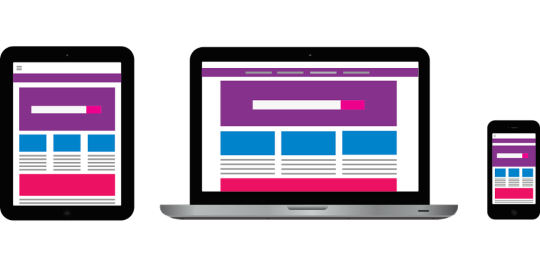
User-friendly navigation is the key to a good website. One might be offering the best product or service in the market or rather the world, nevertheless, it would be of no use, if your visitors or customers aren’t able to locate them. The website layout needs to be simple and reasonably organized. Additionally, a prominent search and navigation tabs should be placed on top of each web page. The links to all the main pages of your website should be present on the navigation tab.
Design and Layout

The design and layout are very important for websites today more than ever because of one simple fact which is, once a potential customer comes or lands on your page, it takes only 50 seconds for them to decide whether they want to leave or stay on your website. The design of the website must be in line with the branding strategy so that as soon as a visitor comes on your website; they should be able to understand your company and what you stand for, immediately.
Responsive Design

Over the past few years, the rapid rise in the number of mobile phone users has surpassed computer users. With the growing technology, the internet is now more accessible than ever on larger devices such as TVs.
In order to capitalize on these growing market segments, it is important that your website’s design is responsive towards all types of devices and screen spaces because now you don’t know where your next customer might be looking at you from.
Content Writing

The content of your website is its heartbeat. Since the website provides important details regarding your company and its services and everything you stand for, which is your values, mission, vision, etc it’s important to develop an impactful website and in order to ensure that the web content has to be in line with the company’s brand strategy.
It requires rigorous market research to identify and find terminologies and words which can be used by the target audience to search for specific services or products. Now how can you do that? Read our blog on SEO to find out. Good quality content will make it easier for users to understand and relate to your website.
Call to Action

It is important that your website is equipped with the necessary tools to initiate a Call to Action or commonly known as CTA.
It is important to guide visitors towards activities that are important to you, for example, online purchase, subscribing to your newsletter, promotional emails or availing discounts.
Testimonials

With growing competition in the digital domain, one of the most important things on your website is a testimonial section. The testimonial section showcases the comments or appreciation of satisfied customers which gives your work credibility along with the website. Testimonials and reviews or comments make new visitors and your potential customers feel comforted and a lot more confident about purchasing on your website if it’s an e-commerce platform or else your desired CTA.
Where you place them is your choice completely. You can put them on the home page itself or you can have a separate section for it so visitors can view them on landing.
Story Telling

There’s nothing that a good story can’t do. The biggest brands in the world rely on storytelling as a means to build brand loyalty. Multiple studies suggest that people connect to stories. Thus, for your customers to connect to your brand, it is crucial that the customers know your story. Now how does one do that? The best way of doing that is by having an “About Us” section or “Our Story” on your website that tells the story of your brand, company and/or employees so that your customers relate to it. This helps in adding a personal touch to the website and making a good impression on your visitors.
Contact Information
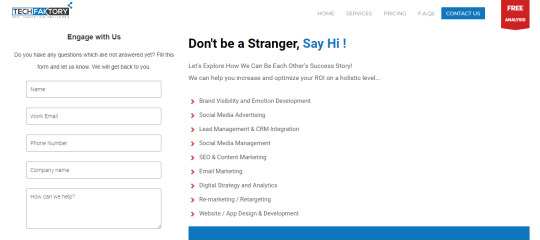
Last but not the least, it is important that your website displays detailed information about how and where to contact you on your website. Make sure that it is prominent. At the end of the day, what you want is for your potential customers to come to you and make a purchase or at least get in touch with you so you can take things forward from there.
When you’re working with your web and mobile app development companies it’s important that you keep these points in mind so that you have your dream website. Now, what’s next? Once you have your website ready the next step is working on your mobile application. Earlier, we had stated how important it is to be mobile-friendly and an app is important to be mobile-friendly. So yes, app development is important for in the digital age that is what some of the best mobile app developers have to say. However, you should only start working on the app when you have a good website with you. So, the app development should be on your agenda only once your website is up and running and you want to take your digital strategy a step forward.
Now that we’ve talked about the website at length, let's understand what you need to do when you’re working on developing your mobile app
TIPS TO DEVELOP YOUR MOBILE APP

Let's talk about what tips the top mobile application development companies in the world have for you:
Understanding the needs of your customer
Needless to say, your app is of little use if doesn’t solve a need your customer has. If it can’t make their experience better, it’s a waste of resources. You must only venture into developing an app when you’re sure you understand what your customer wants.
Developing a prototype
To get things started, it’s important to first know what you want and then get it made to see how it looks.
What might sound good in your head might not look very good on the screen, so it’s important to develop a prototype.
Building a strategy
The strategy is an important part of everything that goes right for you. So, it’s important to know what you’re expecting out of the app. You need to have a thought process for both your long term and short-term goal with the app.
Creating designs and layouts
Like with the website, the design of the website, it’s important that your app has a good design because let’s face it, it doesn’t take long to delete an app and those ratings and reviews could do you a great deal of good.
Testing the application
Hardly anyone gets it right the first time. So, it’s important that you have it tested again and again and then again so once it goes live, it’s making head turns to your app.
You need to ensure there are as little bugs as possible because no one likes a sloppy app.
We know that it looks easy when you read but the ground reality is that a professional touch will give you rewards that are unmatched.
If you need help, our agency will not only help you with custom copy writing but also with a completely custom design and a unique look and ensure your website becomes a workhorse to help you fill your lead pipeline.
If you are looking for a professional website and mobile app development company to build your online presence, then let’s talk.
Visit our website https://www.techfaktory.com/ to connect with us to explore our website and mobile app development services
0 notes
Text
Finding the RIGHT Digital Marketing Agency for Your Business!
In this era of digitization, old-school marketing tactics & techniques are losing their essence, as a result of which most of the companies are moving towards Digital Marketing. Many of the companies rely on the services provided by digital marketing agencies to catch up with the pace of digital transformation and the emergence of new trends all the time.
The question is, is your agency improving your online presence or hampering it?
Did you know, 86% of the digital marketing agencies are doing it wrong or are not aware of the right practices to be followed? Most of the agencies aren’t giving the required attention to their clients and often try to manipulate them by creating irrelevant hype and false reports.
Let’s look at the list of mistakes commonly made by agencies and how to avoid it:
Posting on social media without an end goal:
Many studies reveal that brands aren’t doing meaningful interactions with the users. Content is the king obviously but creating content just to post regularly doesn’t do justice to your social media audience.
2. Defining clear goals of an ad campaign
Marketing plays a critical role in creating a brand image in the mind of the users. Some agencies don’t believe in getting a good understanding of the client’s business and target audience which is why they start working without setting any long-term engagement goals for a client. Is your digital marketing agency understanding the essence of your brand and then delivering results?
3. Lack of transparency
These days, most of the digital marketing agencies use phrases and jargon without having real knowledge of them - keyword research, user integration and lead generation are a few examples. Usually, what they promise isn’t reflected in what they deliver. Ask questions about the services and process you want clarification on. Only a knowledgeable agency will give you concrete answers.
4. Submitting irrelevant reports & analytics: Marketing agencies don’t talk about what’s fundamentally important for your business to grow i.e. brand development, social trust, high-value leads, better customer conversion rate and an ROI that marketing can achieve. Reviewing reports is essential for any business to measure the success of their campaigns. Data manipulation is a common method used by agencies to exploit clients because most of the clients want overnight progress and agencies play on that desire by generating false reports.
5. Outdated methods used by marketing agencies: Traditional marketing agencies who are pioneers in the advertising fraternity lack the manpower or knowledge to adapt to the new age transformation and changing consumer behaviorism. Digital marketing is an extension for these traditional platforms for them. If your marketing agency has started digital marketing recently but hasn’t grown in terms of tools, techniques and technology, it’s time for you to move on and find an agency which is up to date in this era of digitization. Digital marketing is such an ocean of information that even the biggest brands make some common mistakes! To be aware of these mistakes, one needs to choose their marketing partner with precision. Digital marketing is a complicated service that cannot promise overnight miracles. It requires an appropriate investment on the right strategy and patience for return on investment.
How can the RIGHT digital marketing agency help you?
A professional agency understands that digital marketing is successful for a brand when done holistically. Every aspect of this realm is considered and given required attention according to the need. There should be transparency in their process, and they should make sure that their customers are in sync with what they are spending on. Their process should be focused around-
● Identifying your short-term and long-term business goals
● 360° digital marketing plan and social media calendar
● 100% data-driven and tailor-made services
● Integration and Initiation of every relevant social media platform
● Encouraging engagement by posting required content and keeping the audience engaged with active communication
● Client approval-based model
● Developing and executing a cross-channel digital marketing strategy to achieve business goals
● CRM suggestions/implementations
● Extensively focus on re-targeting and re-marketing to potential customers
● Generating regular detailed reports to measure success
Their services should be AI based, data & tech-driven, as digital marketing is not at all about playing blind! Programmatic advertising, personalized and interactive customer experience, push marketing, PR & influencer marketing techniques that have proved in helping a business grow organically and hence, should be a major part of their service portfolio.
In the end, everything comes down to ROI. So, it is important for an agency to be able to justify the cost their customers are paying for digital marketing services.
After all, that is how they build trust and a healthy professional relationship.
Our team at Tech Faktory, loves to share knowledge of this realm and are always looking forward to connecting with people who enjoy discussing the endless possibilities this sphere holds.
Do share with us your digital marketing agency stories. We love to learn what not to do! We shall wait for you to say Hi! at https://www.techfaktory.com/
1 note
·
View note
